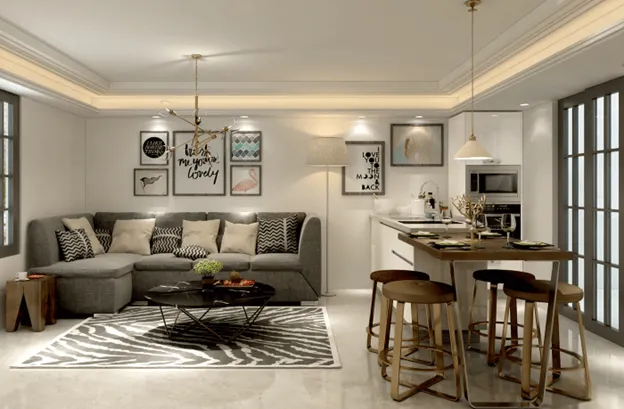Complete guide to studio apartments: where affordability meets luxury
Studio apartments are compact residential units that combine a living area, bedroom, and kitchen into a single open space. Typically ranging between 300 to 600 square feet, studio apartments cater to individuals or couples looking for practical living solutions in urban centers.
The concept of studio apartments arose from the growing need for space efficiency in densely populated cities. Over time, these units have evolved into highly sought-after housing options due to their affordability and adaptability. Today, many studios feature modern layouts, smart storage, and luxury amenities—merging minimalism with comfort.
Why Studio Apartments Matter in Today’s Housing Market
Studio apartments play a crucial role in the housing ecosystem, especially in urban and semi-urban areas. Here’s why they’re increasingly relevant:
-
Affordability: With rising property prices, studio apartments offer a budget-friendly alternative to one- or two-bedroom units.
-
Urban Living: Ideal for professionals, students, and digital nomads who prioritize location over space.
-
Sustainable Lifestyle: Smaller spaces typically mean lower utility bills, reduced energy consumption, and a smaller carbon footprint.
-
Low Maintenance: Less square footage makes cleaning and upkeep easier and less time-consuming.
-
Versatile Design: Open-plan layouts make studios easy to customize based on individual lifestyle and preferences.
Who Benefits Most?
-
Young professionals starting their careers
-
Students looking for accommodation near universities
-
Single retirees downsizing for simplicity
-
Investors seeking high-rental-yield properties
-
Frequent travelers and remote workers
What Problems Do Studio Apartments Address?
-
Urban space constraints
-
Rising rental and housing costs
-
Increased demand for single-occupancy dwellings
-
Desire for efficient, low-impact living
Trends and Changes in the Past Year (2024–2025)
In the last year, several changes have reshaped the studio apartment market globally:
1. Rise in Remote Work Culture
With hybrid and remote work becoming mainstream, many renters seek studio apartments that double as home offices. This has led to developers offering multi-functional furniture and built-in workspaces.
2. Micro-Luxury Movement
Cities like Tokyo, Berlin, and New York are witnessing a surge in high-end studio apartments equipped with smart home tech, rooftop lounges, and in-house gyms—without increasing the footprint.
3. Eco-Friendly Features
From solar panels to water-saving fixtures, many new developments include green building certifications, especially in cities following green urban planning policies.
4. Rent Stabilization and Caps
In cities like Berlin and San Francisco, updated rental policies aim to control rapid rent hikes, making studio apartments even more attractive.
5. Flexible Lease Terms
Platforms like Blueground and Sonder are offering fully-furnished studios with lease terms as short as one month, responding to the demand from digital nomads and gig workers.
Legal and Policy Landscape Affecting Studio Apartments
Laws and regulations significantly influence the development, pricing, and availability of studio apartments. Here’s how policies shape this housing segment:
| Region | Key Regulation | Impact on Studio Apartments |
|---|---|---|
| United States | HUD minimum size guidelines (220–400 sq. ft.) | Ensures livability and safety standards |
| European Union | Urban land use zoning | Limits or encourages development in central city areas |
| India | RERA (Real Estate Regulation Act) | Protects buyers and ensures transparency in studio listings |
| Japan | Building Standards Act | Determines minimum room size and fire safety in micro-apartments |
| Canada | CMHC rental housing programs | Provides subsidies and grants for affordable studio units |
Some cities enforce minimum square footage laws (e.g., New York City’s 400 sq. ft. limit for new builds) to avoid overcrowding and poor living conditions.
Subsidized Housing Programs
Several countries provide subsidies or tax incentives to developers who include affordable studio apartments in their projects.
Rental Laws
Rent control or rent stabilization policies help maintain affordability, especially in cities experiencing housing shortages.
Helpful Tools and Resources
Whether you're looking to rent, buy, or invest in a studio apartment, here are some essential tools and platforms to assist your journey:
-
Zillow, Realtor.com, and MagicBricks – For listings and property comparisons
-
Rentometer – Compare average rent prices in your area
-
Apartment Therapy and Houzz – Interior design ideas and studio makeovers
-
Floorplanner and Roomstyler – Plan layouts and visualize space online
-
Furnished Finder and Blueground – Platforms for short-term, furnished studio rentals
-
Mortgage Calculators (NerdWallet, Bankrate) – Estimate monthly payments and affordability
-
Google Maps – Check proximity to amenities, transport, and workspaces
Frequently Asked Questions
Q1: What is the typical size of a studio apartment?
A standard studio apartment usually ranges from 300 to 600 square feet, though this may vary by country and city regulations.
Q2: How is a studio apartment different from a 1BHK?
A studio apartment combines the living room, bedroom, and kitchen in a single open space, while a 1BHK (1 Bedroom-Hall-Kitchen) has separate rooms for each function.
Q3: Can couples live comfortably in a studio apartment?
Yes, but it depends on lifestyle preferences. Couples who value minimalist living and efficient use of space often adapt well. Some studios offer smart partitions or Murphy beds to increase functionality.
Q4: Are studio apartments a good investment?
Studio apartments often have higher rental yields, especially in urban areas with high single-person occupancy demand. However, resale value growth may be slower than larger units.
Q5: What should I check before renting a studio apartment?
Important factors include:
-
Natural lighting and ventilation
-
Proximity to work, school, or public transport
-
Noise insulation and privacy
-
Storage options
-
Condition of appliances and furnishings
Final Thoughts
Studio apartments offer a smart blend of affordability and functionality, making them a valuable option in the evolving housing market. With the right planning, a small space can feel just as luxurious as a large one—especially when designed efficiently.